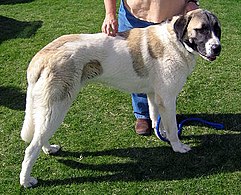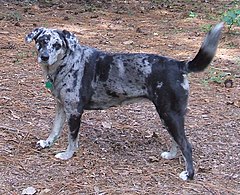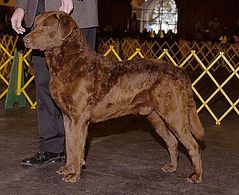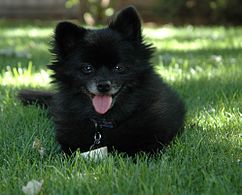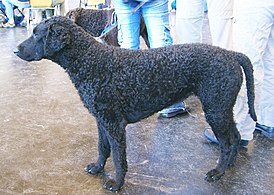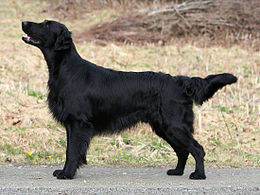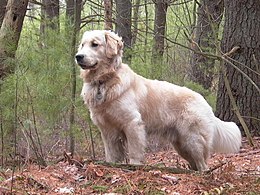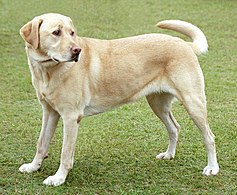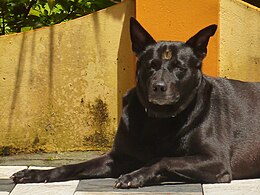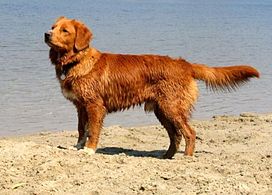Dog breed: Difference between revisions
| Line 93: | Line 93: | ||
<strong>4- Canine Parvo Virus –</strong> Parvo is one the diseases which dog owners need to be most careful about especially in young puppies. This is a gastro intestinal illness which if not treated properly can prove fatal for the dog. This virus spreads very fast in dog population, it is contagious and spreads through fleeces or through contact with someone who is carrying this disease. Young puppies who are between six to eight weeks are most prone to this disease especially if they haven’t got vaccination yet. It is very important to get a vaccination against this virus as they can prove to be very dangerous. There are certain symptoms which show in dogs suggesting of Parvo Virus – these are diarrhea, lethargy, anorexia, fever, weight loss, vomiting etc. if the dog suffers from any of these, a Vet should be consulted immediately and steps should be taken towards the treatment of the dog. If the dog is diagnosed with Canine Parvo Virus, the breed will require intensive care with hospitalization of the breed. It is important that the breed gets diagnosed with this in the early stages before the infection has the capacity to get worse. |
<strong>4- Canine Parvo Virus –</strong> Parvo is one the diseases which dog owners need to be most careful about especially in young puppies. This is a gastro intestinal illness which if not treated properly can prove fatal for the dog. This virus spreads very fast in dog population, it is contagious and spreads through fleeces or through contact with someone who is carrying this disease. Young puppies who are between six to eight weeks are most prone to this disease especially if they haven’t got vaccination yet. It is very important to get a vaccination against this virus as they can prove to be very dangerous. There are certain symptoms which show in dogs suggesting of Parvo Virus – these are diarrhea, lethargy, anorexia, fever, weight loss, vomiting etc. if the dog suffers from any of these, a Vet should be consulted immediately and steps should be taken towards the treatment of the dog. If the dog is diagnosed with Canine Parvo Virus, the breed will require intensive care with hospitalization of the breed. It is important that the breed gets diagnosed with this in the early stages before the infection has the capacity to get worse. |
||
<strong>5- Hip Dysplasia –</strong> This is a condition in which there is deformity in the hip joint of the specie, it generally affects larger breeds. In this the body of the femur may not fit properly into the hip socket. It is a genetic condition mostly and is very common in Golden Retrievers, German Shepherds, Labs, Rottweiler’s etc. This can also occur due to excessive weight gain, poor diet and lack of exercise. There are certain symptoms of this condition including uneven gait, difficulty in standing and running etc.<ref>{{title= |
<strong>5- Hip Dysplasia –</strong> This is a condition in which there is deformity in the hip joint of the specie, it generally affects larger breeds. In this the body of the femur may not fit properly into the hip socket. It is a genetic condition mostly and is very common in Golden Retrievers, German Shepherds, Labs, Rottweiler’s etc. This can also occur due to excessive weight gain, poor diet and lack of exercise. There are certain symptoms of this condition including uneven gait, difficulty in standing and running etc.<ref>{{cite web|title=List of dog diseases|url=https://en.wikipedia.org/wiki/List_of_dog_diseases}}</ref><ref>{{cite web|author=DogSpot|title=Complete Information of dogs|url=https://www.dogspot.in/dog-breeds/}}</ref> |
||
==Breeds== |
==Breeds== |
||
Revision as of 06:24, 25 April 2018
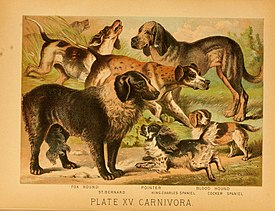
Dog breeds are dogs that have relatively uniform physical characteristics developed under controlled conditions by humans, with breeding animals selected for phenotypic traits such as size, coat color, structure, and behavior.[1] The Fédération Cynologique Internationale recognizes 337 pure dog breeds.
Other uses of the term breed when referring to dogs may include pure breeds, cross-breeds, mixed breeds and natural breeds.
First dog breeds
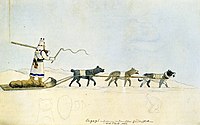
In 2017, a study showed that 9,000 years ago the domestic dog was present at what is now Zhokhov Island, arctic north-eastern Siberia, which was connected to the mainland at that time. The dogs were selectively bred as either sled dogs or as hunting dogs, which implies that a sled dog standard and a hunting dog standard existed at that time. The optimal maximum size for a sled dog is 20-25kg based on thermo-regulation, and the ancient sled dogs were between 16-25kg. The same standard has been found in the remains of sled dogs from this region 2,000 ago and in the modern Siberian Husky breed standard. Other dogs were more massive at 30kg and appear to be dogs that had been crossed with wolves and used for polar-bear hunting. At death, the heads of the dogs had been carefully separated from their bodies by humans, probably for ceremonial reasons.[2]
History

Archaeology has revealed dog remains of various sizes but there does not appear to have been distinctive breeds until 3,000-4,000 years ago when greyhound-type dogs were depicted on pottery and paintings in Egypt and Western Asia. Mastiff-type dogs were kept for guarding and hunting, and short-legged dogs were also bred. By Roman times, most of the breed-types known today were well-defined and their qualities and functions recorded. Dog breeds proliferated in Europe during the Middle Ages 700 years ago.[3] Most modern dog breeds are the products of the controlled breeding practices of the Victorian era (1830-1900),[4][5] and the accurate documenting of pedigrees with the establishment of the English Kennel Club in 1873 in imitation of other stud book registries for cattle and horses.[6]
- For early depictions of dogs in art, see early history.
Genetic evidence of breeds
| ||||||||||||||||||||||||||||||
| Cladogram of 9 breeds that are genetically divergent from others[7] |
Ancient dog breeds
Ancient breed of dogs was a term once used for a group of dog breeds by the American Kennel Club,[5] but no longer.[8] These breeds were referred to as "ancient breeds", as opposed to modern breeds because historically it was believed that they had origins dating back over 500 years. In 2004, a study looked at the microsatellites of 414 purebred dogs representing 85 breeds. The study found that dog breeds were so genetically distinct that 99% of individual dogs could be correctly assigned to their breed based on their genotype, indicating that breeding barriers (pure-bred breeding) has led to distinct genetic units. The study identified 9 breeds that could be represented on the branches of a phylogenetic tree which grouped together with strong statistical support and could be separated from the other breeds with a modern European origin. These 9 breeds had been referred to as "ancient breeds", as opposed to the modern breeds. The study found that the Pharaoh Hound and Ibizan Hound were not as old as believed but had been recreated from combinations of other breeds, and that the Norwegian Elkhound grouped with the other European dogs despite reports of direct Scandinavian origins dating back 5,000 years.[7]
Dog types
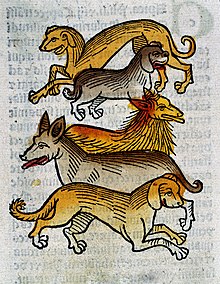
- See further: Dog type
The spread of modern dog breeds has been difficult to resolve because many are the products of the controlled breeding practices of the Victorian era (1830–1900).[4][5] In 2010, a study looked at 48,000 Single nucleotide polymorphisms that gave a genome-wide coverage of 912 dogs representing 85 breeds.[9]
The study found distinct genetic clusters within modern dogs that largely corresponded to phenotype or function. These included spitz-breeds, toy dogs, spaniels, Mastiff-like breeds, small terriers, retrievers, herding dogs, scent-hounds, and sight-hounds. There were 17 breeds that conflicted with phenotype or function and these were thought to be the result of crossing some of the other phenotypes. As in a 2004 study that found 9 ‘ancient breeds’ to be genetically divergent, the study found 13 breeds that were genetically divergent from the modern breeds: the Basenji, Saluki, Afghan hound, Samoyed, Canaan dog, New Guinea singing dog, dingo, Chow Chow, Chinese Shar Pei, Akita, Alaskan malamute, Siberian husky and American Eskimo dog. Results also indicated that the Basenji had recent admixture with Middle Eastern wolves.[9]
The study found that there were three well-supported groups that were highly divergent and distinct from modern domestic dogs. The three groups were
- an Asian group (Dingo, New Guinea singing dog, chow chow, Akita and Shar Pei) that showed past admixture with Chinese wolves,
- a Middle Eastern group (Afghan hound and Saluki), and
- a northern group (Alaskan Malamute and Siberian Husky).[9]
Basal breeds
In 2012, a study looked at 49,000 Single nucleotide polymorphisms that gave a genome-wide coverage of 1,375 dogs representing 35 breeds, 19 wolves, and previous published genetic signatures of other breeds, giving a total of 121 breeds covered. The study found a deep genetic split between old-world and new-world wolves, and confirmed the genetic divergence of 13 breeds from a 2010 study plus another 3: the Eurasier, Finnish Spitz and Shiba Inu. The study referred to these 16 as Basal breeds, as opposed to ancient breeds, as they exhibited genetic divergence but not all of them were historically considered to be "ancient breeds".
The 2012 study found that modern breeds only emerged in the 19th century and that claims of their antiquity are based on little or no historical or empirical evidence. The study indicated that throughout history, global dog populations experienced numerous episodes of diversification and homogenization, with each round further reducing the power of genetic data derived from modern breeds to help infer their early history.
Of the basal breeds, the American Eskimo Dog and Eurasier were the very recent product of cross-breeding other basal breeds. Most basal breeds have hybridized with other lineages in the past. If those other lineages were other basal breeds then a basal genetic signature remains. The combination of introgression and past population bottlenecks suggested that basal breeds have little or no genetic connections to their ancestral populations and that their genetic distinctiveness does not signify ancient heritage. They are distinctive from the modern breeds because the genetic heritage of the modern breeds has become blurred due to admixture, and the basal breeds have mostly avoided admixture with them due to geographic or cultural barriers.[10]
Medical research
As dogs are a subspecies but their breeds are distinct genetic units, and because only certain breeds share the same type of cancers as humans, the differences in the genes of different breeds may be useful in human medical research.[11]
Breed temperament
In 2014, a study indicated that some breed-temperaments, such as anxiety or fear, may be linked to gene mutations. Other temperaments may be due to the legacies of 'ancient' ancestry.[12]
Breed Diseases
Dogs are prone to a number of diseases which affect them and at the same time their owners. A pet in pain is one of the most painful images to see. There are certain ways, through which these diseases can be minimized and the pain that the breed goes through reduced. One of the best ways to do this is to get an early knowledge of the disease, recognize its symptoms early on so that treatment can begin early which may save the breed from a lot of trouble. Effective weight management and a balanced diet also go a long way in preventing diseases. Some of the diseases to watch out for are listed below-
1- Canine Distemper – Canine distemper is a kind of virus infection which doesn’t carry with it, a cure. It is contagious in nature and can be very harmful for the specie. This virus attacks puppies who are young and haven’t got the vaccination yet. Older dogs who weren’t vaccinated are also susceptible to this illness. This virus is contagious and can spread through air or infected utensils in the breed. Generally contact with an infected animal also leads to the spread of the disease. The infection starts from the lymph nodes and spreads to the respiratory organs of the breed. The initial symptoms of this disease would be high temperature, coughing, and wheezing, red eyes. The dog will appear extremely tired and exhausted. In the later stages the nervous system of the dog gets affected, there can be fits, seizures etc. This disease can lead to demise also, generally in a period between 2-5 weeks of the virus’s infection. A vaccinated breed is generally prevented from this outbreak. A combination of Biochemical tests and Urine tests are done to diagnose this disease.
2- Kennel Cough – The early symptoms of Kennel cough is endless coughing and the sound that the dog might be choking on something. Kennel cough is not a life threatening disease but it can be extremely painful for the breed. It is treatable and a number of times the pet recovers without medication. There are several reasons why your breed may develop kennel cough, but the most reoccurring reason is the presence of this bacterium called Bordetella bronchiseptica. Generally, the inhalation of this bacteria leads to an infection in the windpipe of the breed which leads to inflation. There are some causes which are predominant in making a breed susceptible to Kennel cough they are cold temperatures, stress which happens due to travelling too much, crowded places and inhalation of cigarette and other kind of smoke. Generally dogs who suffer from Kennel cough have coughing fits and likes but will not have decreased energy levels or anything like that. This condition is contagious and can spread from one breed to the other, It is important to keep other pets away from the one suffering from Kennel cough. This one doesn’t treatment but pneumonia can happen after kennel cough so regular monitoring should be done of the breed suffering from Kennel cough.
3- Canine Corona Virus – Corona Virus is a kind of intestinal infection that affects breeds across the world. This disease when stands alone is not that harmful to the pet but in case it occurs with other intestinal issues, it can prove to be fatal for the specie if not treated properly. In case of adult dogs, the symptoms might appear to be nonexistent. In case of other younger puppies there are some apparent symptoms like vomiting, diarrhea and in later stages anorexia and depression are also there. There is a lot of dehydration also when this virus hits. In small puppies if there is severe infection in the intestine, it may also result in death. The causing agent of this is called Canine Corona virus which may come from the infected specie. Other causes of this infection can be dogs present in overcrowded places, un sanitary conditions and stress because of too intense training. Generally a couple of tests are done to determine the cause of this infection and treated thereof. There is a vaccine available which may help prevent the specie from contracting this disease but other than that the owner should check regularly for fleeces in the specie.
4- Canine Parvo Virus – Parvo is one the diseases which dog owners need to be most careful about especially in young puppies. This is a gastro intestinal illness which if not treated properly can prove fatal for the dog. This virus spreads very fast in dog population, it is contagious and spreads through fleeces or through contact with someone who is carrying this disease. Young puppies who are between six to eight weeks are most prone to this disease especially if they haven’t got vaccination yet. It is very important to get a vaccination against this virus as they can prove to be very dangerous. There are certain symptoms which show in dogs suggesting of Parvo Virus – these are diarrhea, lethargy, anorexia, fever, weight loss, vomiting etc. if the dog suffers from any of these, a Vet should be consulted immediately and steps should be taken towards the treatment of the dog. If the dog is diagnosed with Canine Parvo Virus, the breed will require intensive care with hospitalization of the breed. It is important that the breed gets diagnosed with this in the early stages before the infection has the capacity to get worse.
5- Hip Dysplasia – This is a condition in which there is deformity in the hip joint of the specie, it generally affects larger breeds. In this the body of the femur may not fit properly into the hip socket. It is a genetic condition mostly and is very common in Golden Retrievers, German Shepherds, Labs, Rottweiler’s etc. This can also occur due to excessive weight gain, poor diet and lack of exercise. There are certain symptoms of this condition including uneven gait, difficulty in standing and running etc.[13][14]
Breeds

Pure breeds
Kennel clubs

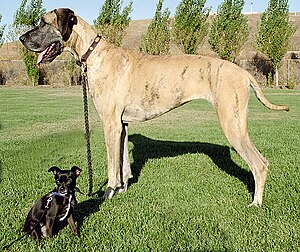
Groups of owners that have dogs of the same breed and have an interest in dog breeding can form national Kennel clubs. Kennel Clubs maintain breed standards, record pedigrees in a breed registry (or studbook), and issue the rules for conformation dog shows and trials and accreditation of judges. They often serve as registries, which are lists of adult purebred dogs and lists of litters of puppies born to purebred parents.
A dog breed is represented by a sufficient number of individuals to stably transfer its specific characteristics over generations. Dogs of same breed have similar characteristics of appearance and behavior, primarily because they come from a select set of ancestors who had the same characteristics.[15] Dogs of a specific breed breed true, producing young that are very similar to their parents. An individual dog is identified as a member of a breed through proof of ancestry, using genetic analysis or written records of ancestry. Without such proof, identification of a specific breed is not reliable.[16] Such records, called stud books, may be maintained by individuals, clubs, or other organizations.
Kennel clubs provide the recognition of distinct dog breeds, but there are many independent clubs with differing, and sometimes inconsistent standards and they need not apply scientific standards. Four varieties of the Belgian Shepherd Dog are recognised as four distinct breeds by the New Zealand Kennel Club.[17] Further, some groups of dogs which clearly share a persistent set of characteristics and documented descent from a known foundation stock may still not be recognized by some clubs as breeds. For instance, the feist is a hunting dog raised in the Southern United States for hunting small game. Feists have a consistent set of characteristics that reliably differentiate them from other dog types and breeds. However, the United Kennel Club recognizes one breed of feist, the Treeing Feist, while the American Kennel Club does not recognize any feist breed.
A dog is said to be purebred if their parents were purebred and if the dog meets the standards of the breed. Purebred dog breeders of today "have inherited a breeding paradigm that is, at the very least, a bit anachronistic in light of modern genetic knowledge, and that first arose out of a pretty blatant misinterpretation of Darwin and an enthusiasm for social theories that have long been discredited as scientifically insupportable and morally questionable."[18] Morally questionable policies regarding purity of breed include obligatory surgical procedures to spay or neuter animals in numerous contexts. The American Kennel Club, for instance, allows mixed-breed dogs to be shown but requires these animals to be altered. It doesn't make such requirements for purebred dogs. California Assembly Act AB 1634 was a bill introduced in 2007 that would require all non-working dogs of mixed breed over the age of 6 months to be neutered or spayed.[19] The bill was morally controversial, leading the American Kennel Club to fight the bill.[20]
The Canadian department of agriculture has strict standards for the documenting of what it calls "evolving breeds".[21]
Breed standards
The breed standard for each breed of dog is distinct, giving a detailed "word picture"[22] of the appearance and behaviour of an idealized dog of that breed. Included in the breed standard description are externally observable aspects of appearance and behaviour that are considered by the breed club to be the most important for the breed, and externally observable details of appearance or temperament that are considered by the breed club to be unacceptable (called faults). In addition, most breed standards include a historical section, describing the place of origin and the original work done by the breed or its ancestor types.
Major registries
Dogs with a breed standard may be accepted into one or more of the major registries (kennel clubs) of dog breeds include the Fédération Cynologique Internationale (covering 84 countries), The Kennel Club (UK), the Canadian Kennel Club, the American Kennel Club, the United Kennel Clubs International, the Australian National Kennel Council the New Zealand Kennel Club, and other national registries. The registry places the breed into the appropriate category, called a group. Some Groups may be further subdivided by some registries.
Health issues
Pure breed dogs have more health problems than mongrel dogs, and require more veterinary visits,[23] and tend to have lower longevity.[24][25] Indeed, studies have reported lifespans that are shorter by between one and almost two years.[26][27] Notably, dog breeds with flat faces and short noses have breathing difficulties,[28] eye trouble and other health issues. [29]
List of pure breeds
The Fédération Cynologique Internationale recognizes over 400 dog breeds.
- Refer: List of dog breeds
Cross-breeds
A dog crossbreed is the result of mating two different breeds.[30]
Mixed-breeds
A mixed breed is the result of mating different breeds.[31] A mixed-breed, mutt or mongrel is a dog that is not the result of artificial selection.[32]
Natural breeds
Natural breeds rose through time in response to a particular environment and in isolation from other populations of the species.[33] This environment included humans but with little or no selective breeding by humans.[34]
- See further: Landraces
Groups of dogs mistaken for breeds
Dog types are broad categories of dogs based on form, function or style of work, lineage, or appearance. In contrast, modern dog breeds are particular breed standards, sharing a common set of heritable characteristics, determined by the kennel club that recognizes the breed. Examples include the huntaway and other livestock dogs of New Zealand, the feist dogs of the southern United States, and the Patagonian sheepdogs of Argentina, which are collies mixed with other working dogs.[35]
List
Images
-
Anatolian Shepherd Dog
-
Catahoula Leopard Dog
-
Chesapeake Bay Retriever
-
Pomeranian (unknown variety)
-
Curly-coated Retriever
-
Flat-coated Retriever
-
German Shepherd Dog
-
Golden Retriever
-
Labrador Retriever
-
Murray River Curly-coated Retriever
-
Local dog breed seen in India. They have a similar appearance to the Indian pariah breed.
-
Nova Scotia Duck Tolling Retriever
-
Old English Sheepdog
-
Pyrenean Shepherd
-
Rafeiro Do Alentejo
-
Saint Bernard
-
Greater Swiss Mountain Dog
See also
References
- ^ Irion, D (2003). "Analysis of Genetic Variation in 28 Dog Breed Populations With 100 Microsatellite Markers". Journal of Heredity. 94 (1): 81–7. doi:10.1093/jhered/esg004. PMID 12692167.
- ^ Pitulko, Vladimir V.; Kasparov, Aleksey K. (2017). "Archaeological dogs from the Early Holocene Zhokhov site in the Eastern Siberian Arctic". Journal of Archaeological Science: Reports. 13: 491. doi:10.1016/j.jasrep.2017.04.003.
- ^ Clutton-Brock, J., 1995. Origins of the dog: domestication and early history. In:Serpell, J. (Ed.), The Domestic Dog, its Evolution, Behaviour and Interactions with People. Cambridge University Press, Cambridge, pp. 7-20
- ^ a b Wilcox, Bonnie; Walkowicz, Chris (March 1995). Atlas of Dog Breeds of the World (Print) (5th ed.). Neptune City, NJ Lanham, MD: TFH Publications, Inc. p. 912. ISBN 0793812844.
- ^ a b c American Kennel Club (2006). Complete Dog Book. Ballantine Books; 20 edition. ISBN 0345476263.
- ^ Clark, Annie Rodgers; Brace, Andrew H. (1995). The International Encyclopedia of Dogs. New York: Howell Book House. p. 8. ISBN 0-87605-624-9.
In the strictest sense, dog breeds date back only to the last couple of decades of the nineteenth century, or to more recent decades in this (the twentieth) century but distinct types of dogs have existed centuries earlier.
- ^ a b Parker, H. G.; Kim, L. V.; Sutter, N. B.; Carlson, S; Lorentzen, T. D.; Malek, T. B.; Johnson, G. S.; Defrance, H. B.; Ostrander, E. A.; Kruglyak, L (2004). "Genetic Structure of the Purebred Domestic Dog". Science. 304 (5674): 1160–4. Bibcode:2004Sci...304.1160P. doi:10.1126/science.1097406. PMID 15155949.
- ^ American Kennel Club. "Dog breed groups".
- ^ a b c vonHoldt, Bridgett; Lohmueller, Kirk E.; Han, Eunjung; Parker, Heidi G.; Quignon, Pascale; Degenhardt, Jeremiah D.; Boyko, Adam R.; Earl, Dent A.; Auton, Adam; Reynolds, Andy; Bryc, Kasia; Brisbin, Abra; Knowles, James C.; Mosher, Dana S.; Spady, Tyrone C.; Elkahloun, Abdel; Geffen, Eli; Pilot, Malgorzata; Jedrzejewski, Wlodzimierz; Greco, Claudia; Randi, Ettore; Bannasch, Danika; Wilton, Alan; Shearman, Jeremy; Musiani, Marco; Cargill, Michelle; Jones, Paul G.; Qian, Zuwei; et al. (17 March 2010). "Genome-wide SNP and haplotype analyses reveal a rich history underlying dog domestication". Nature. 464 (7290): 898–902. Bibcode:2010Natur.464..898V. doi:10.1038/nature08837. PMC 3494089. PMID 20237475.
{{cite journal}}: Explicit use of et al. in:|author2=(help) - ^ Larson, G (2012). "Rethinking dog domestication by integrating genetics, archeology, and biogeography". Proc. Natl. Acad. Sci. U.S.A. 109: 8878–83. doi:10.1073/pnas.1203005109. PMC 3384140. PMID 22615366.
- ^ Cadieu, Edouard; Ostrander, Elaine A. (2007). "Canine Genetics Offers New Mechanisms for the Study of Human Cancer". Cancer Epidemiology Biomarkers & Prevention. 16 (11): 2181–2183. doi:10.1158/1055-9965.EPI-07-2667.
- ^ Serpell, James A.; Duffy, Deborah L. (2014). "Domestic Dog Cognition and Behavior": 31. doi:10.1007/978-3-642-53994-7_2. ISBN 978-3-642-53993-0.
{{cite journal}}:|chapter=ignored (help); Cite journal requires|journal=(help) - ^ "List of dog diseases".
- ^ DogSpot. "Complete Information of dogs".
- ^ Donna L. Morden; Seranne, Ann; Wendell J. Sammet; Gasow, Julia (2004). The joy of breeding your own show dog. New York, N.Y: Howell Book House. ISBN 0-7645-7302-0.
- ^ Lynn Marmer (1984). "The New Breed Of Municipal Dog Control Laws:Are They Constitutional?". first published in the University of Cincinnati Law Review. Archived from the original on 26 September 2000. Retrieved 13 December 2013.
The court found it was impossible to identify the breed of an unregistered dog.
{{cite web}}: Unknown parameter|deadurl=ignored (|url-status=suggested) (help) - ^ "Standards of the Breeds: Group 5 – Working" (PDF). New Zealand Kennel Club.
- ^ Budiansky", Stephen (2000). The Truth About Dogs; an Inquiry into the Ancestry, Social Conventions, Mental Habits, and Moral Fiber of Canis familiaris. New York, U.S.A.: Viking Penguin. p. 35. ISBN 0-670-89272-6.
- ^ "Archived copy". Archived from the original on 25 October 2009. Retrieved 4 December 2008.
{{cite web}}: Unknown parameter|deadurl=ignored (|url-status=suggested) (help)CS1 maint: archived copy as title (link) - ^ http://www.akc.org/canine_legislation/CA_action_center.cfm
- ^ "Animal Pedigree Act 1985". Department of Justice, Canada. Archived from the original on 26 July 2012. Retrieved 9 April 2008.
{{cite web}}: Unknown parameter|dead-url=ignored (|url-status=suggested) (help) - ^ American Kennel Club Glossary
- ^ Egenvall, A.; Hedhammar, A.; Bonnett, B. N.; Olson, P. (29 April 2000). "Gender, age, breed and distribution of morbidity and mortality in insured dogs in Sweden during 1995 and 1996". Veterinary Record. 146 (18): 519–525. doi:10.1136/vr.146.18.519. ISSN 2042-7670. PMID 11321213.
- ^ Bonnett, B. N.; Egenvall, A.; Olson, P.; Hedhammar, Å (12 July 1997). "Mortality in insured Swedish dogs: rates and causes of death in various breeds". Veterinary Record. 141 (2): 40–44. doi:10.1136/vr.141.2.40. ISSN 2042-7670. PMID 9253830.
- ^ Proschowsky, Helle Friis; Rugbjerg, Helene; Ersbøll, Annette Kjær (30 April 2003). "Mortality of purebred and mixed-breed dogs in Denmark". Preventive Veterinary Medicine. 58 (1–2): 63–74. doi:10.1016/S0167-5877(03)00010-2. PMID 12628771.
- ^ O’Neill, D. G.; Church, D. B.; McGreevy, P. D.; Thomson, P. C.; Brodbelt, D. C. (1 December 2013). "Longevity and mortality of owned dogs in England". The Veterinary Journal. 198 (3): 638–643. doi:10.1016/j.tvjl.2013.09.020. PMID 24206631.
- ^ Patronek, Gary J.; Waters, David J.; Glickman, Lawrence T. (1 May 1997). "Comparative Longevity of Pet Dogs and Humans: Implications for Gerontology Research". The Journals of Gerontology Series A: Biological Sciences and Medical Sciences. 52A (3): B171–B178. doi:10.1093/gerona/52A.3.B171. ISSN 1079-5006. PMID 9158552.
- ^ How fashion has left this dog gasping for air
- ^ Vets warn people against buying 'flat-faced' dogs
- ^ "cross-breed". Oxford Dictionaries. Oxford University Press. 2014.
- ^ "mixed-breed". Oxford Dictionaries. Oxford University Press. 2014.
- ^ Morris, Desmond (2008). "Feral dogs". Dogs: The Ultimate Dictionary of over 1,000 Dog Breeds (First Paperback ed.). Vermont: Tralfalgar Square. pp. 696–697. ISBN 978-1-57076-410-3.
The mongrel is not a true breed, but it is certainly a common category of domestic dog
- ^ Sponenberg, D. Phillip (18 May 2000). "Genetic Resources and Their Conservation". In Bowling, Ann T.; Ruvinsky, Anatoly (eds.). The Genetics of the Horse. Wallingford, Oxfordshire, UK: CABI Publishing. pp. 392–393. ISBN 0-85199-429-6. Retrieved 28 September 2014.
- ^ Coppinger, Raymond & Lorna Coppinger. Dogs. Scribner 2001, ISBN 0-684-85530-5, Chapter 3, "Natural Breeds", p. 85. "Natural breeds can arise locally with no human interaction"
- ^ Rorem, Linda. "Herding Dog Breeds - Stockdog breeds". Herding on the Web. Archived from the original on 3 December 2013. Retrieved 13 December 2013.
{{cite web}}: Unknown parameter|deadurl=ignored (|url-status=suggested) (help)
Further reading
- Alderton, David (September 2008). Encyclopedia of Dogs (Hardcover). Bath: Parragon Inc. p. 384. ISBN 1407524380. ISBN 9781407524382.
- Coile, D. Caroline (1 April 2005). Encyclopedia of Dog Breeds: Profiles of More than 150 Breeds (2nd ed.). Barron's Educational Series, Incorporated. p. 368. ISBN 9780764157004.
- De Prisco, Andrew; Johnson, James B. (1993). Canine Lexicon. T. F. H. Publications. p. 886. ISBN 3-929545-60-8. ISBN 978-3-929545-60-9,.
{{cite encyclopedia}}: CS1 maint: extra punctuation (link) - Kister, Kenneth F. (1994). Kister's Best Encyclopedias (2nd ed.). Phoenix: Oryx. pp. 329–330. ISBN 0-89774-744-5.
- De Vito, Dominique (1 September 2005). World Atlas of Dog Breeds (Print) (6th ed.). Neptune City, NJ Lanham, MD: TFH Publications, Inc. Distributed in the U.S. to the Bookstore and library trade by National Book Network. p. 960. ISBN 0793806569. ISBN 978-0793806560.
- DK Publishing (15 July 2013). The Dog Encyclopedia (Hardcover) (1st ed.). DK Adult. p. 360. ISBN 1465408444. ISBN 978-1465408440.
- Wilcox, Bonnie; Walkowicz, Chris (March 1995). Atlas of Dog Breeds of the World (Print) (5th ed.). Neptune City, NJ Lanham, MD: TFH Publications, Inc. Distributed in the U.S. to the Bookstore and library trade by National Book Network. p. 912. ISBN 0793812844. ISBN 9780793812844.
External links
- Fédération Cynologique Internationale breeds nomenclature, lists 339 dog breeds in 78 groups
- Dog Breed Characteristics will give you an historical overview of dog breeds.

